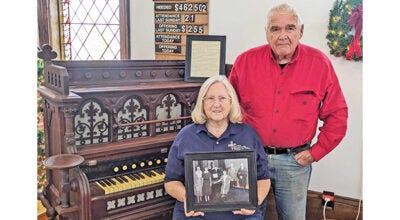Ask Trooper Rob: Proper seating key for young passengers
Published 10:10 pm Wednesday, May 16, 2012
Q: I would like to know how old a child passenger on a motorcycle must be and if there’s a fine. — Fred, an internet reader.
A: Fred, the following is what the law says about passengers. As you see, there is not an age requirement. Per the vehicle code, the passenger must be able to place their feet upon the proper foot pegs and be in a proper seating position. For example, a small child wearing a helmet, sitting on the fuel tank would not be authorized per the Motor Vehicle Code as this is not an authorized seating position and there are no foot rests or pegs.
257.658 Riding on seat of bicycle, motorcycle… (2) A bicycle or motorcycle shall not be used to carry more persons at one time than the number for which it is designed and equipped… (4) A person operating or riding on a motorcycle, and any person less than 19 years of age operating a moped on a public thoroughfare shall wear a crash helmet on his or her head.
Crash helmets shall be approved by the department of state police. (This law was recently repealed; however, if the operator or passenger is younger than 21 age, he or she is still required to wear the crash helmet on the motorcycle).
Further, MVC 257.658a, Seats and footrests; requirements; exception; violation as civil infraction. (1) In addition to the requirements of section 658, a motorcycle shall be equipped with adequate seats and foot rests or pegs for each designated seating position.
Foot rests or pegs must be securely attached. A passenger shall not ride on a motorcycle unless his or her feet can rest on the assigned foot rests or pegs except that this requirement does not apply to a person who is unable to reach the foot rests or pegs due to a permanent physical disability.
(2) A person who violates this section is responsible for a civil infraction (a traffic ticket with a fine from the court).
One of the most violent days and dramatic manhunts in the history of the Michigan State Police and Indiana State Police began about 3 p.m. Sept. 30, 1957.
While on lookout for a stolen car on U.S. 112 southwest of Clinton in Lenawee County, Tpr. Douglas Vogel flagged down a speeding motorist, Victor Whitely, who could not produce a proper registration.
Being suspicious of the situation, Vogel began to search the trunk of Whitely’s vehicle. While doing so and unaware, Whitely’s armed robbery partner, Ralph Taylor, stopped a ways behind the patrol car and snuck up on Vogel, asking why he stopped the vehicle.
Shooting spree
As Vogel turned around, he saw Taylor with a gun. Vogel attempted to disarm Taylor and was shot, falling into the ditch where he was shot twice more. Vogel emptied his six-shot revolver but was unable to hit Taylor. Whitely and Taylor escaped.
Vogel summoned all his strength to climb from the ditch and radio for help and give a description of the vehicles and direction of escape. Vogel would later receive life-saving surgery and would become the fourth and last living trooper to receive the Valor Medal.
After dispatching an ambulance for Vogel, Sgt. Fred O’Donnell jumped into a patrol car with Tpr. Dugald Pellot, 23, who had enlisted in the department on May 17, 1956.
Rushing to the scene, they saw the two cars and attempted to get close to Taylor’s car. Pellot was about to shoot out the tires with a shotgun, but Taylor saw this and stopped.
Pellot rushed the car and Taylor, who saw this, was waiting and shot Pellot, killing him instantly with a shot to the heart.
O’Donnell was also shot at but was not wounded. He did return fire and creased Taylor’s skull causing a superficial wound.
More than 130 patrol cars, each carrying two troopers, began searching an area 150 miles long by 100 miles wide. Deputies and local officers joined the hunt. All total, more than 400 police officers were searching for the killers.
Hostages taken
Ohio and Indiana police were also alerted. Taylor and Whitely, in their escape, would eventually kidnap two people and steal their cars.
After midnight on Oct. 1, 1957, Indiana Tpr. William Kellems stopped the second stolen car. Taylor killed him instantly as he approached.
Their escape from that shooting led them to an Indiana blockade, where a fierce gun battle ensued. Two other police officers were injured and Taylor was mortally wounded. The pair of fugitives then took a deputy hostage and escaped from that scene.
Shortly after departing, Taylor died and either fell or was pushed from the vehicle.
The deputy’s car eventually stalled and Whitely escaped, leaving his gun behind and the deputy and his car. He eventually surrendered.
Whitely was convicted of murder and kidnapping in Indiana and received a double life sentence.
Pellot and Kellems were buried simultaneously in Michigan and Indiana, with both states sending representatives to the funerals.
Pellot’s widow received a posthumous Valor Medal. Pellot was the 21st trooper to die in the line of duty.





